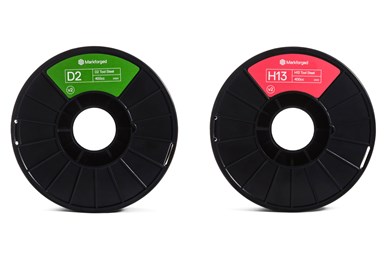Markforged Reformulates H13, D2 Tool Steel for More Flexible, Less Brittle Filaments
The new filaments are reformulations of Markforged’s most popular tool steels.
Markforged’s newest versions of H13 Tool Steel and D2 Tool Steel filaments were developed to be used with its Metal X 3D fused filament fabrication (FFF) printing system and feature an updated binder that results in a significantly more flexible and less brittle filament. The additional materials are part of the company’s strategy to strengthen manufacturing resiliency by enabling industrial production at the point of need.
The new filaments are reformulations of Markforged’s most popular tool steels. The company says these materials improve quality of life and printer performance for its customers, while enabling future print modes that increase the breadth of applications the Metal X could support.
The updated H13 and D2 tool steel spools can be loaded in an unheated Metal X chamber, which reduces startup and material changeover time. The new spools also contain 400 cc of material, which is twice as much material than the older versions, enabling more printing to be done before needing to change spools.
The company says the Metal X is one of the most intuitive metal 3D printers available. It is purpose-built for consistent part quality and a user-friendly experience. Markforged combines software that gets smarter with every print along with constant materials research and innovation to deliver a wide range of industrial-grade parts quickly and reliably.
The H13 tool steel is a versatile hot work tool steel for manufacturing operations. Harder than 17-4 PH stainless steel and capable of maintaining material properties at high temperatures, H13 tool steel is a versatile material with which to work. Markforged H13 can be heat treated to 45 HRC with a UTS of 1680 MPa, and is used by Markforged customers for tool bodies, brazing fixtures and other parts where hardness or heat resistance are required.
D2 tool steel is a cold work tool steel optimized for a variety of manufacturing applications. D2 are cold work tool steels defined by their extremely high hardness after heat treatment. D2 tool steel is harder and more wear-resistant than A2 tool steel, but less tough. It can be used for cutting and forming tools, or other applications where high hardness are valued.
- Learn about Markforged’s Digital Source Platform which enables printing parts on-demand. The platform enables manufacturer-certified parts to be licensed and printed at the point of need.
- Read about Markforged Adding a simulation feature to its additive manufacturing software. The software’s virtual testing can validate the strength of advanced composite parts and automatically optimize print parameters to lower cost and speed production.
Related Content
-
7 Takeaways on 3D Printing As a Pathway to Polymer’s Future
The Cleveland section of SPE hosted “Additive Manufacturing: Printing the Path for the Future” on October 17, 2024. Speakers signaled where AM is and where it is headed with session topics ranging from pellet-based 3D printing to qualification and commercialization of additively manufactured products.
-
UltiMaker Targets Light Industrial Applications With 3D Printer Designed for the Factory Floor
The company’s Factor 4 3D printer introduced this week is designed to complement conventional manufacturing equipment including CNC machining and automation.
-
For Coast Guard, AM Adoption Begins With “MacGyver-ish” Crew Members Who Are Using 3D Printing Already
AM suits the Coast Guard’s culture of shipboard problem-solving, says Surface Fleet AM lead. Here is how 3D printers on ships promise to deliver not just substantial cost savings but also an aid to crew capabilities and morale.















